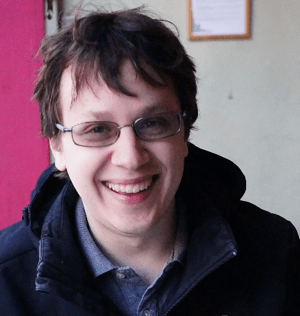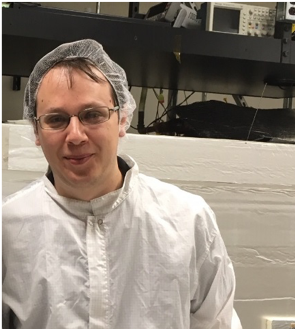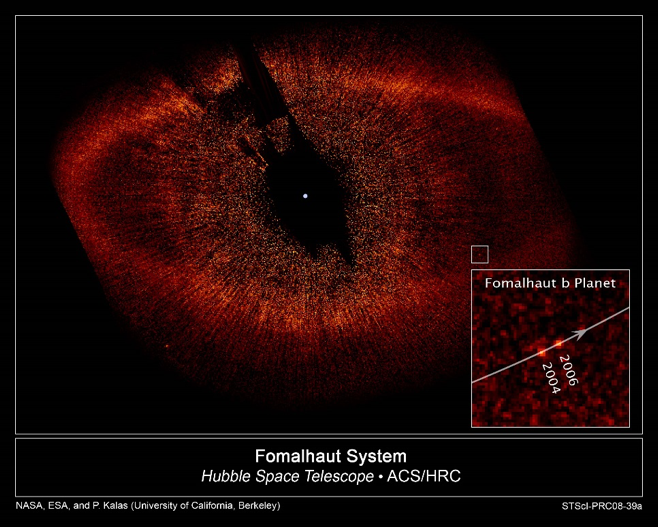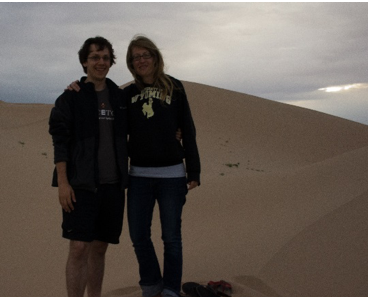We generally start with your childhood, your interests and hobbies early in life, and if there was anything in your early years that might have focused or oriented you toward pursuing the career you’re in now?
I was born in Bucharest, Romania. I moved to Canada with my parents when I was 12, and I lived both on the east and west coast of Canada. I lived in Ottawa and I did middle school and high school there, and then I moved to Edmonton for undergraduate studies, at the University of Alberta. Then I came to the U.S. for graduate school which was 10 years ago. I was in grad school at Princeton on the east coast, and I came to the west coast after I finished that for my postdoc at Ames and now, I’m a research scientist here.
Tell us a little bit about your family and why they moved from Romania to Canada, what occasioned that move?
Romania in the ’90s was very chaotic during the post-socialist transition. My parents had the opportunity to move to Canada and they did. I’m very grateful to them because I had a lot of educational opportunities in North America.
Quite a change for a 12-year-old!
Yes, that’s right.
In terms of the majors and topics you pursued in school, tell us about those and what led you to pursue those and not something else.
I always had an interest in sciences, in physics. What I liked about physics and math was that you could work logically on a problem and its solution, and you could understand things about the world around you. And in high school, this is what piqued my interest in space science. We had an extracurricular club, so after school, in the evenings, we would do this, it was called the Space Simulation Club. Every year we would pick a mission destination and we would work all year towards making this mission happen. There would be a group of “astronauts” selected and they would be the ones that lived in the habitat, living on the surface of the planet. There would be another group of “simulators” who would prepare that surface and create experiments for them to do. It was really a great experience. For instance, I was a “pilot” one year and I had to navigate the landing on Ida and Dactyl a binary asteroid pair which was quite challenging to do. We had a homebrew N-body solar simulator to perform the trajectory transfers, so this was really advanced work that we were doing back in high school. I was very fortunate to get a chance to do that. And it inspired me to look at doing something in space science. When I graduated from high school and as an undergraduate, I got the chance to work for a few summers in an astronomical instrumentation group led by David Naylor at a university in a small town in Canada called Lethbridge. I got to build, I was doing electrical engineering at the time, the electronics that would go into water vapor monitor units that were measuring the amount of water vapor along the line of sight of the telescope. And it would be able to post-process the phase delay due to the water vapor along the line of sight of the telescope.
Yeah, for sure! OK, and then in your university education?
I did electrical engineering for my undergraduate studies. I thought about doing physics, I thought about doing computer science. I ended up choosing electrical engineering because it was the most practical choice and it combined both.
I was just going to say, it was the most broadly applicable thing, and you’ve got to be looking at supporting yourself for the rest of your life!
Yes, that’s right! That’s kind of how the decision went. But actually, it all really fitted very well together because I got this experience working in undergrad on astronomical instrumentation, and then I became fascinated by a specialization in electrical engineering called control engineering, which involved optimizing control loops, designing systems. And when I applied for grad school, I found a group at Princeton led by Jeremy Kasdin that was doing both astronomical instrumentations and was applying control theory to build technology to image exoplanets. When I saw that, I thought “this is perfect!” because it unites both strands of my interests. And an advantage of my engineering background was it allowed me to start seeing connections between things I did — how scientific concepts are applied to build instrumentation that then allows you to learn more about the world around. I was very fortunate to put these two interests together for my graduate education.
Sure! And then at some point, you applied for a postdoctoral fellowship at NASA?
Yes. For my Ph.D. work with Jeremy Kasdin and Bob Vanderbei, I got exposed to doing exoplanet technology research. There are two techniques for doing this: coronagraphy and starshades which allows you to directly image exoplanets. The challenge with directly imaging exoplanets is that the starlight is 10 orders of magnitude brighter than the exoplanet. And coronagraphy allows you to suppress starlight so that you can directly see the exoplanet with an instrument inside the telescope. My Ph.D. project was to run a scaled starshade experiment.
How does that work?
It involves two spacecraft flying in formation. You have one spacecraft that is specially shaped, it looks like a flower, it has a set of petals that basically approximates an ideal transmission function that would create the darkest possible shadow. And these petals, it turns out you can’t actually manufacture this ideal transmission function, and that’s how you end up having this flower shape instead. The occulter spacecraft creates a shadow on the telescope, 50,000 km away from your starshade spacecraft. The challenge that I had for my Ph.D. was that we needed to test this on the ground so we scaled a starshade to laboratory dimensions and checked that the optical tools that we used to design the spacecraft actually worked and you actually get the shadow that you desire.
Is that at all analogous to holding your hand above your eye to shade it when looking toward a bright light?
Yes, that’s the basic principle. It’s creating an artificial eclipse if you like. But it turns out that, if you just put, let’s say, a circular screen, the shadow isn’t dark enough. Light acts like a wave and diffracts around the circular stop. This is the Huygens-Fresnel principle. And you basically get a bright spot at the center of your shadow and rings. That shadow is far too bright, so that’s where designing the shape of the starshade comes into play by optimizing the depth of the shadow.
Is it different for each target, the shape?
No, it’s just one starshade with a fixed shape that can be moved around the sky. So you need to align it with your telescope when observing.
But you can point it at different stars or planets on the same mission?
Yes, that’s right. You have to slew the starshade across the sky perhaps for a couple of weeks, depending on next target star is and when it comes into alignment you can perform observations. If there are any planets then you can characterize them, pass the light through a spectroscope and identify absorption features — you would be able to see what features the atmosphere might have. And the thing that’s very interesting is that the current concepts are using both the coronagraph and starshades together. It turns out the most optimal solution, and this is one of the missions that NASA is looking at, it’s called HabEx, the most optimal solution is to actually combine coronagraphy with starshades and discover exoplanets with a coronagraph and then follow up with the starshade for characterization.
So, I take it that your Ph.D. project was successful, that you were able to demonstrate that this can work?
I was able to demonstrate that we can understand the performance of starshades in a particular regime which corresponded to larger starshades than are being designed for missions like HabEx. I also designed a new testbed that ended up being built and showed excellent performance. And at that point, I came here to Ames to work as a postdoc on coronagraphy. I’m still interested in starshades and synergies with coronagraphs; I’m also exploring locations at Ames where it is possible to build the next generation testbed.
I presume that somewhere along the line you met or knew of Rus Belikov, and applied to have him as your advisor for your postdoc?
Yes, Rus was at Princeton but we never actually overlapped; he came to Ames the summer before I started as a graduate student. Rus actually built many of the tools at Princeton that the coronagraph experiment was using. And it’s all really about optical science and understanding the propagation of light very accurately and being able to model it mathematically. Designing and validating systems that can work to the precision level that we require, which is actually very stringent.
How does this type of work, this avenue of science that you’re pursuing with trying to image exoplanets, fulfill NASA’s mission of exploration? And can you defend your particular work to the taxpayers?
Here at Ames, we’ve had the Kepler mission, which was one of the most successful missions that NASA ever had. And Kepler has told us that there are exoplanets wherever you look. They come in a variety of sizes and separations from their stars and there’s this huge diversity and an unexpectedly high frequency of exoplanets. And now the question is, what about the planets in our backyard? What about the stars near us? What exoplanets do they have? Being able to image exoplanets in stars around us, the nearest stars to us, that’s really exciting and I think that is the next step, after Kepler.
So, what is a typical day like for you? How do you spend your time?
It’s varied a lot. When I first came to Ames, I was part of this experiment that our group was running at Lockheed-Martin. We were doing vacuum demonstrations for a mission called EXCEDE (Exoplanetary Circumstellar Environments and Disk Explorer). I was commuting to Palo Alto and we were running an experiment there to demonstrate that the coronagraph instrument worked. After that project ended, I’ve been working here, we have an in-air testbed here at Ames. I focus primarily on modeling and computer simulations to improve the performance of the wavefront control loop and then testing these out experimentally. Now we have a project, joint with JPL and we’ll be doing experiments in the vacuum chamber at JPL’s High-Contrast Imaging Testbed starting next month. We’ll be running experiments remotely at JPL, so my routine changes depending on the current project, it’s not boring, never the same.
And all of this is building toward being able to fly a mission? And maybe I missed it along the way, but is the mission planning at a point where you, what would be the timeline where you would actually be able to fly?
For exoplanet imaging, the mission that is scheduled next is WFIRST (Wide Field InfraRed Survey Telescope). It will have a coronagraph instrument on board and it’s currently planned to launch in the mid-2020s.
Is that the first NASA mission that will have that?
It is the first NASA mission that will have a high contrast coronagraph, with a wavefront control system. Actually, Hubble has a basic coronagraph that has directly imaged a planet around Fomalhaut. That discovery came out when I had just started grad school and it pointed the way forward for what direct imaging with space instrumentation can do. The Hubble coronagraph is not very high-contrast and isn’t able to see exoplanets in reflected light, but it’s been able to see large self-luminous planets, dust rings, and debris disks. That was the first coronagraph in space but WFIRST will be the first high-performance coronagraph in space that will be able to see exoplanets. And Rus Belikov, Eduardo Bendek, Sandrine Thomas, and I proposed a technique to be able to image planets around binary stars. A lot of the work I’ve done over the last couple of years has been to demonstrate that this technique works with planned flight instruments. We are aiming to apply it to WFIRST so we could augment WFIRST capabilities without any changes to the coronagraph.
What do you like best and least about your job?
What I enjoy most is — I never imagined I would get to do this. As a child, I never imagined I’d be at NASA now and work on this exciting science. I’m basically living my dream. What I don’t like is that it’s actually a real job and you have some bits that come with it such as paperwork that you have to deal with. That was not part of my dreams! (laughs).
My, you’re the first person that’s mentioned paperwork! Not. In fact, one of the questions we have is, and you mentioned that you are doing your dream job, did you ever think on the way before you got here, did you have another idea about what your dream job would be? Before you became what you are now?
Well, when I was in high school and we had the Space Simulation Club, I was an astronaut on our mission, so I imagined I would be an astronaut. Then I found out you can’t be an astronaut if you don’t have perfect vision. I would be disqualified from that. But there are a lot of exciting things you can do in space science and engineering and I’m very glad to be able to do that.
What advice would you give to some aspiring young person that would like to have the kind of job that you have now?
Looking back at my past, I have been very fortunate to get to work things that were cool and interesting to me personally. I volunteered in an astronomical instrumentation group when I was in high school and that opened up opportunities that I was able to put together, in ways that I hadn’t imagined. I was able to put together my engineering background with space science. I would say that doing something that’s interesting to you and looking at ways to apply your background, I think there are new opportunities that will come out of that.
Anything you want to share about your family, your personal life, wife, kids, pets, anything beyond just your work? Hobbies, talents, things that you do when you’re not here?
I like to read a lot. When I was young, I read a lot of science fiction, and I have kept up reading, Isaac Asimov and Jules Verne were authors who really inspired me early on. Since I spend a lot of time looking at a computer screen and doing modeling and electronic paperwork, I like to get away from that in a couple of ways: I like to play board games with my wife and friends, board games have been really a fun way to interact with people. Actually, some of the board games that I’ve played recently have a space science theme! Being in the Bay Area, we also have access to a lot of unique cultural opportunities. One musician whose concerts I’ve always wanted to see is Jordi Savall. Turns out he’s performed in the Bay every year since we’ve been here.
And you speak four languages you said?
Yes, that’s right. I grew up speaking Romanian at home; in Canada, French is the second official language and you take it in middle school and high school. I also learned German in kindergarten — my grandparents were running a German-language kindergarten. After German, English was easy to pick up!
Have you ever been back to Romania?
I’ve only been back to Romania twice. I have family there, but it’s a long way! And my immediate family including my brother and my parents live in Alberta, in Canada, so to visit family I usually go there.
What accomplishment in your life is most meaningful to you that’s not science-related?
Meeting my wife. We met in graduate school in Princeton. My wife is an anthropologist and it’s a very different way of thinking about and looking at the world, so I’ve been very fortunate to meet her and to have learned so much from her.
So, you take care of the planets way out there and she takes care of the planet here! It’s intriguing when you said that she’s an anthropologist. Is there such a thing as a practicing anthropologist? A lot of people teach it. What does she actually do?
She teaches anthropology at De Anza. And she’s done fieldwork in Mongolia. When we were in grad school, she spent two years doing her fieldwork and I visited her for a few weeks in Mongolia. That was very exciting. I went to her field site and also took a tour of the country including the Gobi desert. I found that Mongolia is a beautiful country. It was great to be there and visit her.
Was she on some kind of a fellowship or award to do the research?
All anthropology graduate students at Princeton do a couple of years of fieldwork supported by their graduate fellowship. She was studying a mining town called Erdenet in the northern part of Mongolia.
Who or what inspires you? You mentioned Isaac Asimov as a science fiction writer. Is there anyone or anything else that draws you toward excellence or to want to be your best?
Well, I’ve had different mentors who have inspired me in different interests and pursuits. When I was young, I found Asimov fascinating and he really inspired me to think of space science and to think of the future of humanity in space, which has been one of my deep interests. When I was in high school, the mentor for our space mission club had a Ph.D. and he was extremely influential in developing my interest in space science, and actually doing really interesting things in high school.
We would like to get a favorite quote or something like that.
Yes, it’s a quote by Christiaan Huygens, who was one of the first optical scientists, and an astronomer. When I was writing up my dissertation, I was wondering how long-ago people considered that there might be planets around other stars. And Christiaan Huygens considered that and there is this quote, but he basically said that “we learn by traveling and by being in different places and having different experiences. And how profound it would be to know that there are other planets around other stars and that there would be planets like ours”. Here’s the exact quote. It’s from a book he wrote 300 years ago discussing the possibility of life on other planets:
“We may mount from this dull Earth; and viewing it from on high, consider whether Nature has laid out all her cost and finery upon this small speck of Dirt. So, like Travellers into other distant countries, we shall be better able to judge of what’s done at home, know how to make a true estimate of, and set its own value upon every thing. We shall be less apt to admire what this World calls great, shall nobly despise those Trifles the generality of Men set their Affections on, when we know that there are a multitude of such Earths inhabited and adorn’d as well as our own.”
Is there anything about your life or your work that you wish we would have asked you but we didn’t?
I’d like to talk a little more about the work that I’m doing now, that allows us to look at binary stars. As I mentioned, I’m working with Rus and Eduardo and this is work that I’ve been doing the last two years after I completed my postdoctoral fellowship.
Binary stars would certainly be a complication in the work you’re trying to do.
That’s right. Typically, high contrast imaging systems are designed just to look at one star, and the second star introduces an additional challenge because you have to deal with two stars, not just one star. For many of the binaries, it turns out that the second star is bright enough to prevent you from seeing an exoplanet if it is there. So we developed a technique to be able to deal with a binary star using the wavefront control system that is already available onboard a coronagraph. And what’s exciting about this is that 50% of stars are actually located around binary stars. So that’s one aspect of my recent work that’s interesting. And it’s come about from looking at augmenting traditional methods and looking at how we can use these new ideas in a way that we didn’t think about before. And to do something that we didn’t know we could before.
Great, thank you!
Interview conducted by Fred & Sara on 7/30/19































